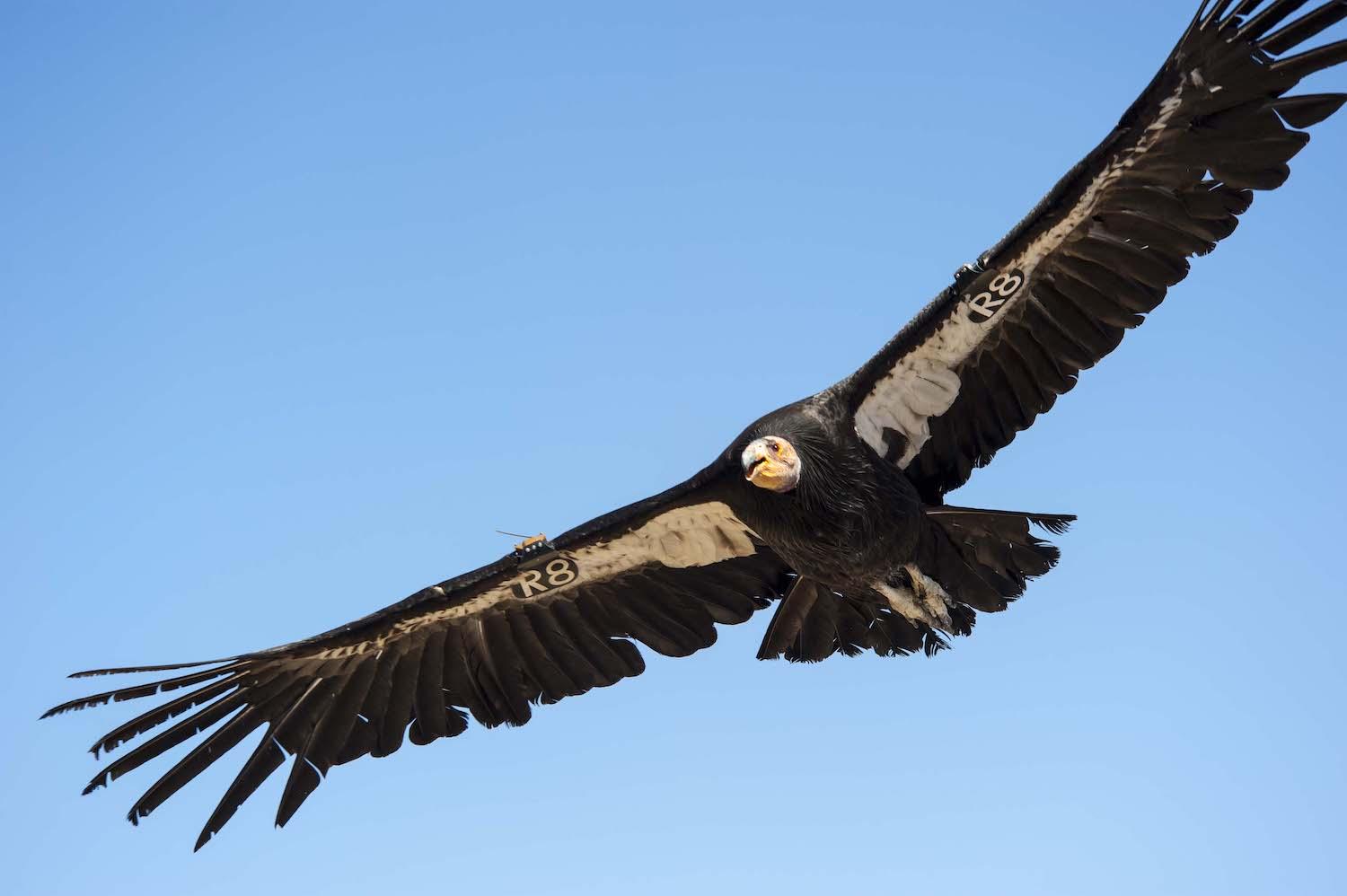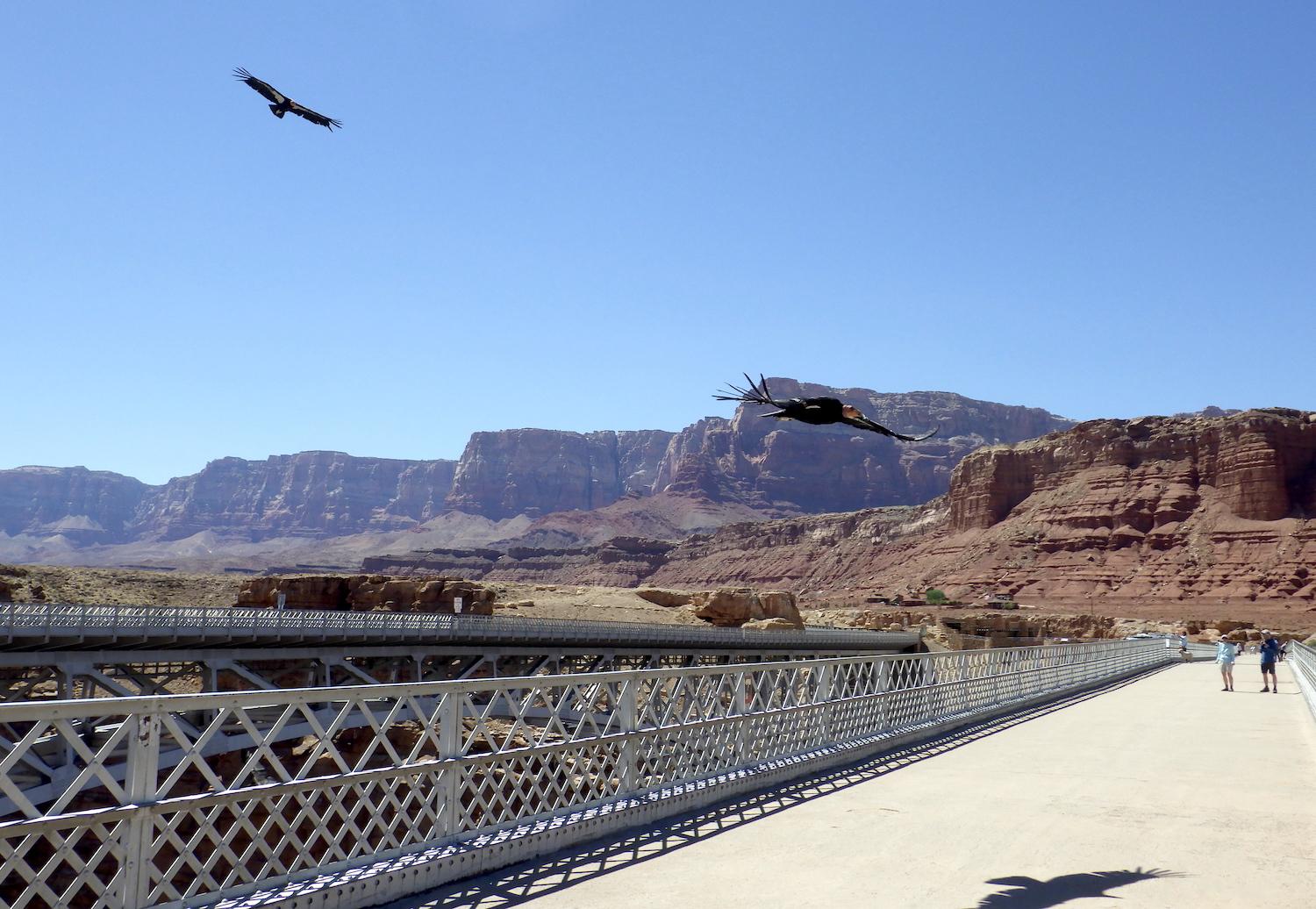
Condor V9 over the Colorado River at the Navajo Bridge/Patrick Cone
Condors Over The Colorado
By Kurt Repanshek
It was as if they were waiting for us. Almost as soon as we set foot on the historic Navajo Bridge at Glen Canyon National Recreation Area, the condors took to the air, stretching their massive wings to catch a ride on the afternoon thermals.
First one, then two, then four of the California condors that once numbered just 27 in the wild were soaring over the Colorado River down below and then seemingly strafing us, with two soaring perhaps 10 feet overhead.
While condor numbers in the wild are increasing, the big birds are far from being downlisted from their current status as an endangered species. Still, as Contributing Editor Kim O'Connell noted earlier this year, the increase in numbers—and especially the successful hatching and fledgling of a wild condor chick in Zion National Park in 2019 — has conservationists hopeful that the species’ long-term prospects are improving.

R8 gliding overhead/Patrick Cone

Two condors soar low over the Navajo bridges/Kurt Repanshek
Leading the effort is the Peregrine Fund, a nonprofit conservation organization that is headquartered at the World Center for Birds of Prey in Boise, Idaho, and operates a condor facility at Vermilion Cliffs National Monument in northern Arizona. Once birds arrive there from breeding facilities, they are tagged and prepared for release into the canyon country that stretches from northern Arizona into southern Utah.
If you have a chance to spot these birds in the wild and can make out the tags on their wings, there's a website you can visit to learn a little history of the birds you saw. For instance, R8 is a male that was hatched on April 29, 2015, and let free in September 2017. V9 is a female born in April 2017 and released in October 2018.
As we stood on the historic Navajo Bridge in late April, we were mesmerized by these incredible birds as they let the warm day's thermals carry them high above the Colorado River, before turning to dive towards us on the bridge. As they passed just overhead, we could hear the wind rustling through their features.
It was a good day, both to be a condor and to be a human watching them.

The wider, modern Navajo Bridge on the right replaced the historic one on the left, which is now a pedestrian bridge/NPS
The two bridges can be found on Highway 89A between Bitter Springs and Jacob Lake, Arizona. On the west side of the historic bridge you'll find a seasonal visitor center and bookstore. On the Navajo Nation (east) side of the bridge, there is an area for Native American craft vendors.
Support National Parks Traveler
Your support for the National Parks Traveler comes at a time when news organizations are finding it hard, if not impossible, to stay in business. Traveler's work is vital. For nearly two decades we've provided essential coverage of national parks and protected areas. With the Trump administration’s determination to downsize the federal government, and Interior Secretary Doug Burgum’s approach to public lands focused on energy exploration, it’s clear the Traveler will have much to cover in the months and years ahead. We know of no other news organization that provides such broad coverage of national parks and protected areas on a daily basis. Your support is greatly appreciated.
EIN: 26-2378789
A copy of National Parks Traveler's financial statements may be obtained by sending a stamped, self-addressed envelope to: National Parks Traveler, P.O. Box 980452, Park City, Utah 84098. National Parks Traveler was formed in the state of Utah for the purpose of informing and educating about national parks and protected areas.
Residents of the following states may obtain a copy of our financial and additional information as stated below:
- Florida: A COPY OF THE OFFICIAL REGISTRATION AND FINANCIAL INFORMATION FOR NATIONAL PARKS TRAVELER, (REGISTRATION NO. CH 51659), MAY BE OBTAINED FROM THE DIVISION OF CONSUMER SERVICES BY CALLING 800-435-7352 OR VISITING THEIR WEBSITE. REGISTRATION DOES NOT IMPLY ENDORSEMENT, APPROVAL, OR RECOMMENDATION BY THE STATE.
- Georgia: A full and fair description of the programs and financial statement summary of National Parks Traveler is available upon request at the office and phone number indicated above.
- Maryland: Documents and information submitted under the Maryland Solicitations Act are also available, for the cost of postage and copies, from the Secretary of State, State House, Annapolis, MD 21401 (410-974-5534).
- North Carolina: Financial information about this organization and a copy of its license are available from the State Solicitation Licensing Branch at 888-830-4989 or 919-807-2214. The license is not an endorsement by the State.
- Pennsylvania: The official registration and financial information of National Parks Traveler may be obtained from the Pennsylvania Department of State by calling 800-732-0999. Registration does not imply endorsement.
- Virginia: Financial statements are available from the Virginia Department of Agriculture and Consumer Services, 102 Governor Street, Richmond, Virginia 23219.
- Washington: National Parks Traveler is registered with Washington State’s Charities Program as required by law and additional information is available by calling 800-332-4483 or visiting www.sos.wa.gov/charities, or on file at Charities Division, Office of the Secretary of State, State of Washington, Olympia, WA 98504.

 Support Essential Coverage of Essential Places
Support Essential Coverage of Essential Places
Comments
What a thing to experience, Kurt!
That looks amazing. What an experience! I went to the Condor talk at the Grand Canyon South Rim, but unfortunately I never did see them during the course of my stay. I would have loved to.
Ravens are a nice consolation prize though. I've seen them at almost every western park I've been to, and they never get old and are always entertaining to watch.